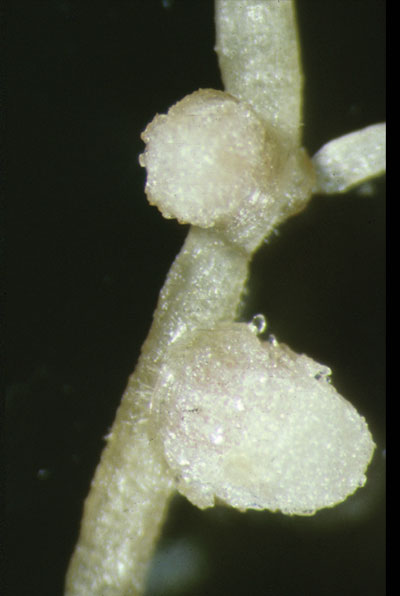
Features
Agronomy
Other Crops
Basic research could dramatically change crop production
Newly identified genes may lead to a new generation of crop breeding and produce crops quite different from today’s plants.
May 1, 2009 By Helen McMenamin
Newly identified genes may lead to a new generation of crop breeding and produce crops quite different from today’s plants. Scientists have identified the genes that control a plant’s ability to develop nitrogen-fixing nodules and others that determine whether the plant completes its whole life cycle in one season or persists from year to year as a perennial.

|
| Developing nodule. Photo courtesy Giles Oldroyd. |
At the John Innes Centre in Britain, Dr. Giles Oldroyd studies nitrogen fixation, particularly the initiation and development of a healthy nodule. The rhizobia bacteria and the seedling must co-ordinate their activities in some way to allow the bacteria to invade the plant, settle in a nodule and receive sugars from the plant in exchange for a supply of ammonia compounds the plant can use for its growth and development.
The process involves metabolites, particularly flavonoids, released from the plant roots, which cause rhizobia to release a powerful signaling compound called a Nod factor. This in turn causes the root hairs of the plant to wrap around the rhizobia bacteria, which divides to develop a microcolony and invade the developing nodule.
Despite the complex cooperation between plant and rhizobium there are key switches that set off at least parts of the cascade of events. By auto-activating a single gene, Oldroyd and his team flipped one of these switches on, causing plants to develop root nodules without the bacteria or its Nod factor.
The auto-activated gene is found in all plants, so it may be possible to develop root nodules on any plant by inserting one of these particular genes.
Revolutionizing science in just 20 years
Developing non-legumes that nodulate and develop symbiotic relationships with nitrogen-fixing bacteria is the ultimate goal of the research. Oldroyd, who is now in his early 30s, expects to see it achieved during his research career. “Twenty years ago, it was pie in the sky to think we could develop crops like wheat that could produce their own nitrogen,” he says. “Now, it’s a much more reasonable goal. The research is moving very quickly. We’re working on transferring the ability to recognize symbiotic bacteria in tobacco and rice.”
Tobacco is a favourite model plant for scientists to test such technology.
“We have a good handle on the mechanism of bacteria-plant recognition,” adds Innes. “But, we’re a long way from understanding how the plant and the bacteria accept one another and work together.”
The next step for Oldroyd’s team is to infect the nodule with bacteria in an effort to understand how the bacteria modify the plant’s physiology to transport nutrients to and from the nodule. In total, he says, 12 genes are needed for perception of the nitrogen fixing bacteria and all plants have seven of the genes.
Understanding nodulation and nitrogen fixation may help identify and develop rhizobia strains for each crop. Oldroyd is also working to understand how the Nod factor affects plants, which may open opportunities to make nodulation more efficient.
 |
|
| Twenty years ago, the idea of perennial canola was just a dream. |
The prevalence of genes to develop symbiotic relationships with rhizobia and the similarity of the mechanisms in all species reveal evolutionary links. Symbiotic nitrogen fixation probably developed about the time land plants developed, roughly 460 million years ago.
Perennial versions of annual crops
Another group of scientists, at the VIB Institute at the University of Gent in Belgium, has found that only two genes control whether a plant is an annual or perennial. They inactivated the two genes in Arabidopsis plants (thale cress, a small, simple plant often used for genetic research because its life cycle is only six weeks). Instead of flowering, producing seed and dying, the plants persisted, developing into woody bushes that did not flower.
The scientists see their discovery as important to studies of evolution, particularly the development of trees. They suggest the simplicity of the change, deactivating just two genes means that it could have occurred more than once. The identification of part of the mechanism of persistence in perennials may also be important in developing perennial versions of crops.